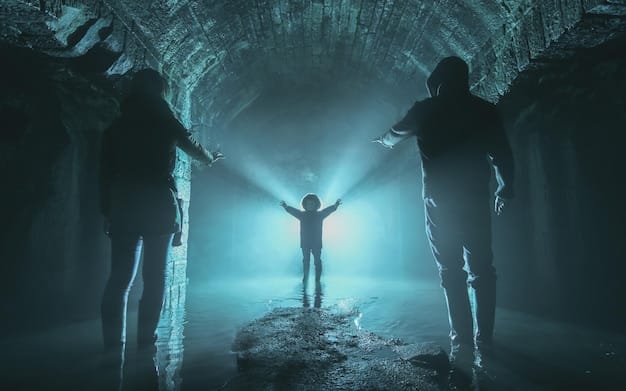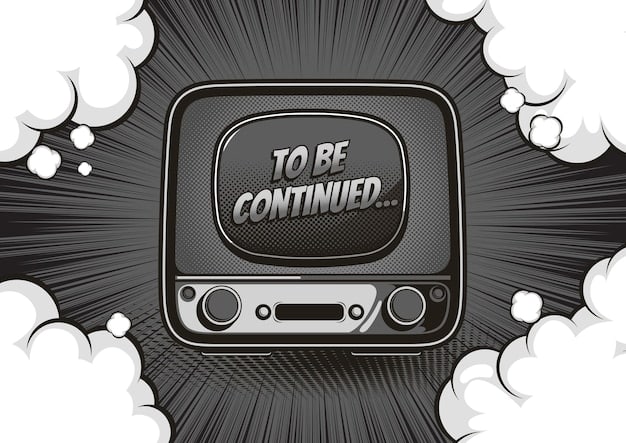The Art of the Cliffhanger: Analyzing Suspenseful Season Endings

The art of the cliffhanger in television series encompasses a sophisticated narrative technique designed to conclude a season with unresolved tension, compelling audiences to eagerly anticipate future installments by skillfully manipulating dramatic reveals and unanswered questions to maximize viewer engagement.
In the vast landscape of television, few narrative devices hold as much power as the cliffhanger. Far more than a simple plot twist, The Art of the Cliffhanger: Analyzing the Most Suspenseful Season Endings represents a carefully crafted appeal to our innate human curiosity, leaving us perched precariously on the edge of our seats, desperate for resolution.
The Genesis of Suspense: Understanding the Cliffhanger
The cliffhanger, a dramatic device where a narrative ends abruptly, leaving the main characters in a precarious, unresolved situation or revealing a shocking new detail, is a cornerstone of serialized storytelling. Initially popularized in 19th-century serialized novels and enhanced by early film serials, its purpose has always been clear: to ensure audience return. This technique thrives on delaying gratification, transforming anticipation into an almost visceral need for answers.
Historical Roots and Evolution
The very term “cliffhanger” is often credited to the serialization of Thomas Hardy’s “A Pair of Blue Eyes” (1873), where a character is literally left hanging from a cliff. Yet, the concept predates this, with works like “The Arabian Nights” relying on narrative suspense to extend storytelling. As media evolved, from radio dramas to television series, so too did the sophistication of the cliffhanger. No longer just about physical peril, modern cliffhangers delve into psychological states, moral dilemmas, and existential threats, reflecting a deeper understanding of audience psychology.
The Psychological Hooks
Why do cliffhangers work so effectively? It taps into our cognitive biases, particularly the Zeigarnik effect, which posits that people remember uncompleted or interrupted tasks better than completed ones. When a season ends on a profound unanswered question or an unaddressed conflict, our brains are hardwired to seek closure. This psychological tension is amplified by the emotional investment viewers develop in characters and their fates. The promise of resolution becomes a powerful motivator, ensuring that audiences flock back for the next season, desperate to mend the narrative’s broken thread.
Cliffhangers are not merely about shocking reveals; they are about disrupting the audience’s equilibrium. They destabilize our understanding of the narrative world, forcing us to re-evaluate what we thought we knew. This intellectual engagement, combined with emotional distress for beloved characters, creates a potent cocktail of suspense that few can resist.
Ultimately, mastering the cliffhanger involves a delicate balance: providing just enough information to intrigue, but withholding enough to frustrate, all while maintaining the integrity of the story. It’s a high-stakes gamble for showrunners, but one that, when executed flawlessly, cements a series’ place in television history as a master of suspense.
Anatomy of a Perfect Cliffhanger: Crafting Unforgettable Endings
Crafting a perfect cliffhanger is a subtle art, requiring precision, foresight, and a deep understanding of storytelling dynamics. It’s not enough to simply end a season abruptly; a truly memorable cliffhanger resonates long after the credits roll, becoming a topic of intense discussion and speculation.
The Elements of Surprise and Impact
At its core, a compelling cliffhanger relies on surprise. This isn’t just about plot twists, but about introducing an unexpected element that profoundly alters the narrative landscape. This could be the sudden death of a major character, a shocking betrayal, or the revelation of a secret that rewrites previously understood timelines. The impact must be immediate and significant, leaving no doubt that the characters’ lives, or indeed the world they inhabit, will never be the same. The element of surprise is heightened when it subverts audience expectations, challenging assumptions they may have held for seasons. It demonstrates the writers’ willingness to take bold risks, a quality audiences often appreciate.
Emotional Resonance and Character Stakes
For a cliffhanger to truly hit home, it must connect on an emotional level. The stakes for the characters involved must be clearly defined and deeply felt. If a protagonist’s life is on the line, the audience should feel their fear and uncertainty. If a moral choice is presented, the weight of that decision should be palpable. Emotional resonance transforms intellectual curiosity into genuine empathy, making the wait for resolution agonizingly personal. The cliffhanger effectively weaponizes the audience’s emotional investment, making them active participants in the suspense.
The Balance of Questions and Answers
A crucial aspect of the perfect cliffhanger is finding the right balance between newly introduced questions and previously answered ones. Too many answers can mitigate the suspense, making the ending feel too complete. Too many questions, conversely, can overwhelm the audience, leading to frustration rather than anticipation. The ideal cliffhanger resolves some minor plot points to provide a sense of progression, while simultaneously opening up a new, larger, and more significant mystery. This provides a clear direction for the next season while ensuring that the immediate past feels somewhat concluded.
The very best cliffhangers often hint at multiple future possibilities, sparking widespread fan theories and discussions. This collective engagement contributes significantly to the series’ ongoing relevance and ensures that audiences are not just passively consuming content but actively participating in its unfolding narrative. It’s about setting up a compelling dilemma or unanswered question that demands continued viewership.
Ultimately, the craft of the cliffhanger lies in its ability to simultaneously satisfy and frustrate, leaving viewers with a profound sense of incompleteness that only the next season can assuage. It’s a narrative high wire act, but one that, when executed flawlessly, can define a series.

Case Studies in Suspense: Iconic Season Endings Analyzed
To truly appreciate the mastery of cliffhangers, examining specific examples that have left indelible marks on television history offers invaluable insights. These moments transcend mere plot points; they become cultural touchstones, sparking watercooler conversations and endless online debates.
“Who Shot J.R.?” (Dallas, 1980)
Perhaps the quintessential cliffhanger, the “Who Shot J.R.?” episode of Dallas transcended television to become a global phenomenon. Ending season three with the conniving J.R. Ewing shot by an unseen assailant, the show left audiences in an unprecedented frenzy. The impact was immense, with “Who Shot J.R.?” becoming a catchphrase and the subsequent season premiere setting ratings records. Its success lay not just in the shocking act, but in the sheer number of characters with motive, making virtually anyone a suspect. This created an expansive web of speculation, proving the power of ambiguity.
“The Rains of Castamere” (Game of Thrones, 2013)
Known colloquially as “The Red Wedding,” the penultimate episode of Game of Thrones‘ third season delivered a brutal and unexpected massacre that redefined what audiences thought was possible on television. The sudden, violent deaths of key protagonists Robb Stark, Catelyn Stark, and their allies left viewers reeling, betrayed, and utterly heartbroken. The genius of this cliffhanger wasn’t just the shock value, but its faithful adaptation of George R.R. Martin’s ruthless narrative, demonstrating that no character was truly safe. It solidified the show’s reputation for unpredictable, high-stakes storytelling.
“Face Off” (Breaking Bad, 2011)
The season four finale of Breaking Bad, “Face Off,” culminated in the explosive, terrifying demise of Gus Fring. After a season-long cat-and-mouse game, Walter White orchestrates Fring’s death in a nursing home bomb blast, but the chilling reveal of Fring adjusting his tie despite half his face being blown off was a moment of shocking, grotesque brilliance. The cliffhanger for the series wasn’t just Fring’s death, but the chilling realization that Walt had become a truly monstrous figure, willing to poison a child to achieve his ends. It left viewers questioning his humanity and anticipating his full, terrifying transformation.
- The Walking Dead (2016): Season 6 finale, “Last Day on Earth,” ended with Negan’s brutal introduction and the murder of an unseen character, leaving audiences guessing for months. The suspense was almost unbearable.
- Lost (2007): The season 3 finale, “Through the Looking Glass,” famously revealed that the “flashbacks” were actually “flashforwards,” showcasing Jack and Kate desperate to return to the island, shattering the show’s core premise.
- The Sopranos (2007): The ambiguous cut to black in the series finale, “Made in America,” left Tony Soprano’s fate open to interpretation, sparking endless debate and cementing its status as one of television’s most daring endings.
These examples illustrate that while shocking reveals are key, the most impactful cliffhangers leverage emotional investment, redefine narrative possibilities, and dare to leave viewers genuinely uncertain about the future. They are not merely endings, but promises of greater, unresolved drama yet to come.
The Pitfalls and Perils: When Cliffhangers Go Wrong
While a well-executed cliffhanger can elevate a series, a misstep can alienate viewers, diminish engagement, and even lead to cancellation. The line between captivating suspense and frustrating manipulation is exceptionally fine, and many shows have inadvertently crossed it.
Audience Frustration and “Jump the Shark” Moments
One of the most significant risks of a cliffhanger is inducing audience frustration. If the unresolved plot point feels arbitrary, illogical, or merely designed to string viewers along without genuine narrative purpose, it can backfire SPECTACULARLY. Prolonged, unsatisfying cliffhangers can lead to a phenomenon known as “jumping the shark,” where a show takes a dramatic, often ridiculous, turn in an attempt to regain relevance or viewership, signaling a decline in quality. This happens when the suspense feels unearned, or when the resolution, once delivered, fails to live up to the built-up anticipation, leaving audiences feeling cheated.
- Unresolved Character Arcs: Leaving too many character stories hanging without progression can feel disrespectful to the audience’s investment.
- Implausible Situations: Cliffhangers that rely on highly improbable events or contrivances can break a viewer’s suspension of disbelief.
- Lack of Payoff: If the resolution to a massive cliffhanger is weak, rushed, or conveniently forgotten in the next season, it teaches the audience that their emotional investment was in vain.
The Risk of Cancellation
For shows on the bubble, a significant cliffhanger is a gamble. While it can generate buzz and potentially secure renewal, it also risks leaving viewers hanging indefinitely if the show is cancelled. There are numerous examples of series ending on unresolved, tantalizing cliffhangers that never received a proper conclusion, much to the chagrin of their dedicated fanbases. This is a cruel irony for viewers who have invested years in a narrative only to have it abruptly cut short at its most crucial moment. The show-runners’ ambition sometimes clashes with commercial realities, resulting in narrative orphanhood.
Lost Momentum and Narrative Bloat
Another pitfall is the loss of momentum during the hiatus. If the cliffhanger isn’t compelling enough to sustain interest, or if the delay between seasons is too long, audiences can lose connection with the story. Furthermore, attempting to resolve an overly complex or grand cliffhanger can lead to narrative bloat in subsequent seasons, forcing convoluted plotlines and extending the story beyond its natural lifespan. The initial tension can dissipate, replaced by a sense of obligation rather than genuine excitement, thereby weakening the overall storytelling quality. The initial intrigue must be carefully nurtured and managed to ensure a satisfying, rather than frustrating, continuation.
Ultimately, the success of a cliffhanger rests not just on the shock of the ending, but on the perceived promise of a satisfying continuation. When that promise is broken, or when the execution falters, the art of suspense can quickly devolve into a source of frustration for even the most loyal viewers.
The Evolving Art: Cliffhangers in the Streaming Era
The advent of streaming services has fundamentally altered the landscape of television consumption, and consequently, the very nature and effectiveness of the cliffhanger. While the core psychological principles remain, the shift from weekly broadcasts to binge-watching has necessitated a re-evaluation of this time-honored narrative device.
Binge-Watching and Reduced Waiting Time
The most significant change brought by streaming is the phenomenon of binge-watching. When an entire season drops at once, the agonizing wait between episodes or seasons that once amplified the cliffhanger’s impact is drastically reduced, or even eliminated. Viewers can immediately move to the next episode, or the next season, effectively diffusing the acute tension. This means cliffhangers now serve a slightly different purpose: instead of compelling weekly tune-ins, they encourage continued engagement within a single viewing session, driving deeper immersion rather than prolonged anticipation. The “watercooler moment” is now more global and less synchronized, occurring whenever individuals catch up.
The Pressure of Immediate Satisfaction
In an era of instant gratification, streaming audiences have grown accustomed to immediate access and resolution. Prolonged, unresolved cliffhangers can feel less like an artful narrative choice and more like an outdated frustration. While traditional TV relied on the cliffhanger to ensure audience return, streaming platforms often prioritize retaining subscribers through consistent, high-quality content that provides satisfying, albeit still open-ended, conclusions. This pushes showrunners to craft cliffhangers that offer a sense of partial closure while still promising future drama, rather than leaving audiences completely in the dark.
The sheer volume of content available on streaming platforms also plays a role. If a cliffhanger is too frustrating, or the wait too long, audiences have countless other options to turn to, making the retention of viewer interest through suspense even more challenging.
There’s a subtle shift from creating a sense of longing for the next season to crafting an ending that feels like a natural punctuation mark before the next chapter begins, without necessarily leaving every character in mortal peril or revealing a world-shattering secret. This maintains a sense of narrative flow rather than a jarring halt.
New Forms of Engagement
Despite the challenges, cliffhangers remain a potent tool in the streaming era, often driving social media engagement and speculative theorizing. Shows like Stranger Things or Ozark consistently end seasons with significant, unresolved dramatic questions that fuel online discussions for months. These discussions, in turn, act as organic marketing, drawing new viewers and keeping existing ones engaged. The nature of engagement has evolved from passive viewing to active participation in fan communities, predicting outcomes and dissecting every subtle clue the cliffhanger provides.
Ultimately, the art of the cliffhanger in the streaming age is about adapting to a new consumption model. It’s about maintaining suspense in less time, using ambiguity to spark conversation, and ensuring that viewers feel a continued desire to embark on the next chapter, even if that means simply clicking “next episode.”

Beyond the Screen: The Cultural Impact of Cliffhangers
The influence of cliffhangers extends far beyond the confines of a television screen, permeating popular culture, influencing other media, and even shaping our collective viewing habits. They become shared experiences, benchmarks in narrative innovation, and powerful tools for cultural discourse.
Forging Shared Experiences
Before the fragmentation of media, cliffhangers were potent catalysts for shared cultural moments. The “Who Shot J.R.?” phenomenon vividly illustrates this; it wasn’t just a plot point, it was a question that united millions across social strata, fueling conversations at work, school, and dinner tables. While the immediate mass synchronized viewing experience is rarer now, major cliffhangers in the streaming era still manage to create immense social media buzz, leading to trending topics, fan art, and elaborate theories. They provide a common language for discussion, fostering a sense of community among viewers who might otherwise consume media in isolation.
Influence on Other Storytelling Forms
The success of television cliffhangers has inevitably influenced other forms of storytelling. Video games, particularly narrative-driven ones, frequently employ cliffhanger endings to encourage players to purchase sequels or DLC. Comic books and graphic novels have always relied on chapter-ending suspense, but the television model has perhaps pushed them to deliver even more impactful season (or volume) conclusions. Novels, too, increasingly use cliffhanger techniques at the end of chapters or books to maintain reader momentum, demonstrating the cross-pollination of effective narrative strategies. Even advertising and political campaigns sometimes adopt the “reveal-next-time” approach to keep audiences hooked.
A Legacy of Anticipation
The legacy of cliffhangers is one of endless anticipation. They have taught audiences to expect, and even demand, narrative complexity and high stakes. For showrunners, they represent a high bar for creative excellence, pushing them to devise increasingly clever and emotionally resonant ways to end seasons. This constant pursuit of heightened suspense has contributed to the evolution of television into a highly sophisticated narrative medium, capable of sustained, complex storytelling that rivals the best of literature and film. Cliffhangers are a testament to the power of unresolved questions and the human desire for answers.
They affirm television’s power not just as entertainment, but as a medium capable of deeply engaging its audience, transforming passive viewers into active participants in an unfolding mystery. The cultural conversation surrounding a major cliffhanger demonstrates its enduring power to capture the collective imagination and to solidify a show’s place in the pantheon of iconic television.
Ultimately, the art of the cliffhanger is a dynamic and evolving force that continues to shape how stories are told and consumed, ensuring that the thrill of discovery and the agony of waiting remain central to the viewing experience.
The Future of Suspense: What’s Next for Cliffhangers?
As technology continues to reshape media consumption, the art of the cliffhanger will undoubtedly adapt, finding new forms and functions in an increasingly interactive and segmented entertainment landscape. The fundamental principles of human curiosity and the desire for resolution will remain, but their application may evolve dramatically.
Interactive Storytelling and Audience Participation
The rise of interactive storytelling, exemplified by choose-your-own-adventure narratives on streaming platforms, presents a fascinating new frontier for cliffhangers. Imagine a season ending with multiple unresolved threads, where audience choices could directly influence which cliffhanger is addressed or how it’s resolved in a subsequent season. This could transform passive viewership into active participation, making the suspense even more personal and engaging. Cliffhangers could become mechanisms for collective decision-making, blurring the lines between audience and creator.
Cross-Platform Cliffhangers
With increasingly interconnected media ecosystems, cliffhangers might extend beyond a single series or platform. A television show could end on a cliffhanger that is then resolved, or further complicated, in a linked video game, graphic novel, or even an augmented reality experience. This cross-platform approach could deepen narrative universes and provide unique ways to maintain audience engagement during hiatuses, turning the wait into an opportunity for immersive, expanded storytelling. The suspense would thus not be confined to the screen but spill over into other interactive forms.
The Role of Artificial Intelligence and Data Analytics
As data analytics become more sophisticated, showrunners might increasingly leverage AI to understand audience reactions to cliffhangers in real-time. This could lead to more precisely engineered cliffhangers designed to maximize specific engagement metrics. While this raises ethical questions about artistic integrity versus algorithmic optimization, it also presents the potential for highly personalized suspense, where the unresolved questions are tailored to resonate most effectively with different audience segments. The balance will be between exploiting data and maintaining creative authenticity.
Ultimately, the future of the cliffhanger is tied to the future of storytelling itself. As traditional boundaries blur and new technologies emerge, the core human desire for resolution will continue to fuel the masterful creation of suspenseful season endings, ensuring that the thrill of the “what happens next?” remains a cornerstone of entertainment. Whether through innovative formats, interactive elements, or sophisticated data insights, the art of the cliffhanger will continue to thrive, adapting to captivate audiences in ever more ingenious ways.
| Key Point | Brief Description |
|---|---|
| 🎭 Narrative Device | Cliffhangers end narratives abruptly, leaving characters in unresolved situations to compel audience return. |
| 🧠 Psychological Impact | They tap into the Zeigarnik effect, creating a need for closure by leaving plots unfinished. |
| 📉 Pitfalls and Risks | Poorly executed cliffhangers can lead to audience frustration, cancellation, or loss of narrative momentum. |
| 🌐 Streaming Era Evolution | Binge-watching shifts cliffhanger purpose from weekly tune-ins to immediate, deep engagement. |
Frequently Asked Questions about Cliffhangers
▼
A true cliffhanger is a narrative device where a story, often at the end of a season, concludes abruptly with characters in danger, a shocking revelation, or a crucial question left unanswered. Its primary goal is to create intense suspense and compel viewers to return for future installments, relying on unresolved tension to drive engagement.
▼
Cliffhangers exploit the Zeigarnik effect, causing viewers to remember unfinished plots more vividly. This creates a strong psychological need for closure, leading to heightened anticipation, speculation, and immediate viewing of subsequent episodes or seasons. They directly influence viewing habits by fostering continued engagement and discussion.
▼
Common mistakes include making the cliffhanger feel unearned or manipulative, failing to provide a satisfying payoff in the next season, or creating an overly complicated situation that frustrates rather than intrigues. If the primary motivation seems to be stalling for time or generating cheap shocks, it can alienate the audience.
▼
In the streaming era, binge-watching reduces the traditional “waiting period” for resolution. Cliffhangers now aim more to encourage immediate continued viewing within a single session rather than prolonged anticipation over weeks or months. While still effective, they must adapt to instant gratification demands to prevent audience disengagement.
▼
Absolutely. Cliffhangers are widely used in novels, comics, video games, and even theatrical plays. They are a fundamental narrative tool for maintaining suspense and encouraging continued engagement across various media. Their core function—leaving an audience craving more—is universal.
Conclusion
The art of the cliffhanger, a narrative stratagem as old as storytelling itself, continues to be a driving force in television and beyond. From literal cliff edges to perplexing ethical dilemmas, these carefully constructed moments of unresolved tension are a testament to our enduring human curiosity and desire for narrative closure. While the medium evolves, particularly with the advent of streaming, the fundamental psychological hooks that make a cliffhanger effective remain constant. When executed masterfully, cliffhangers do more than just end a season; they ignite widespread conversation, deepen emotional investment, and ensure that audiences eagerly await the next chapter, cementing their place as a cornerstone of captivating storytelling.





